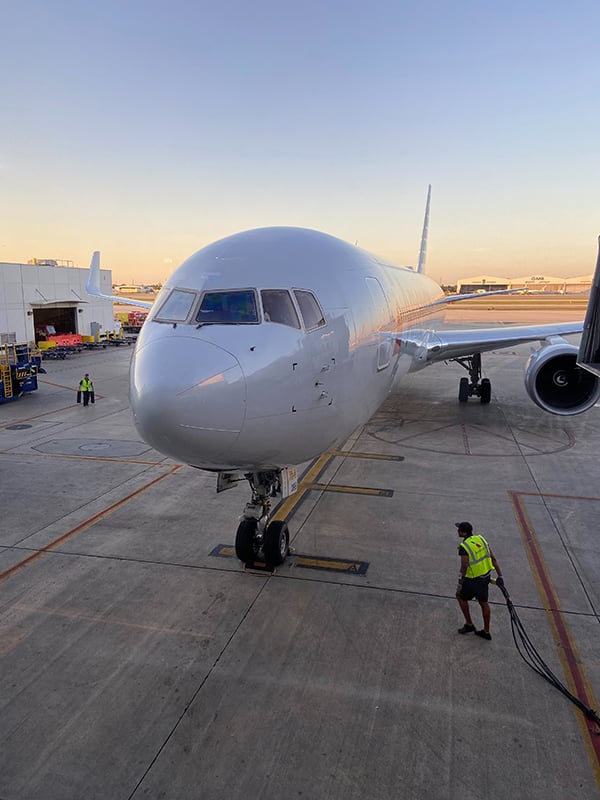How to Understand Fatigue in Aviation SMS

Fatigue is a top safety priority. Even moderate levels of fatigue can cause employees to demonstrate the same mental and physical capabilities as an intoxicated person.
Discussing fatigue in aviation safety management systems (SMS) becomes interesting when one considers the onus for managing fatigue is on multiple parties, namely:
- Civil aviation authority for providing regulatory framework and oversight activities to ensure operators manage fatigue based on scientific principles, knowledge, and operational experience;
- Aviation service providers for providing employee training, defining reasonable duty schedules, and managing fatigue incidents; and
- Individual employees who must report for duty rested and report any fatigue-related concerns to management.
Fatigue is such a high priority that there are even subsystems dedicated to fatigue – Fatigue Risk Management Systems (FRM). Dealing with FRM correctly involves a proper understanding of what fatigue is.
Related Articles on Fatigue Risk Management in Aviation SMS
- Winter Fatigue Hazard Register Review - Aviation SMS SRM & SA Example
- How to Best Monitor Fatigue in Your Aviation SMS
- How to Incorporate Fatigue Risk Management Into Aviation SMS
What Is Fatigue?
Fatigue manifests itself in two ways: physically and mentally. “Manifestations” simply means observable behavior or personal sensation. Physical manifestations of fatigue include:
- General feeling of physical tiredness or lethargy, sometimes described as “feeling heavy”;
- Heavy eyelids or inadvertent nodding off;
- Slowed reaction time; and
- Strong feeling of need to sleep.
Mental manifestations include:
- Difficulties in memorizing information, concentrating, and understanding information;
- Moodiness;
- Tendency to forget information and actions;
- Apathy; and
- Reduced awareness of environment.
Some of the most common causes of fatigue include:
- Overtime;
- Colds, sickness, and illness;
- Night shifts, short nights off (finishing late and starting early) or early morning shifts; and
- High layover duration in different time zones.
What Is Fatigue Risk Management?
Fatigue risk management (FRM or FRMS) is simply a subsystem/approach within an aviation SMS meant for dealing with fatigue. Some organizations have actually dedicated subsystems (FRMS) or simply strategies (FRM) that they can demonstrate to oversight agencies as proof of mitigating fatigue-related safety issues.
What this usually entails is having:
- Safety policies and procedures dedicated to fatigue (Safety Policy);
- A safety incident report dedicated to fatigue (fatigue report) (Safety Risk Management);
- Safety promotional materials dedicated to fatigue (Safety Promotion);
- Methods for monitoring fatigue (Safety Assurance); and
- Safety training dedicated to fatigue (Safety Promotion).
In short, fatigue risk management and fatigue risk management systems are both modeled after aviation SMS implementations in that they address fatigue from the standpoint of the 4 pillars of aviation SMS.
Related Articles on Four Pillars in Aviation SMS
- What Are the 4 Pillars of SMS?
- History of Aviation SMS and Four Pillars - With Free Tools
- Who Started Four Pillars of Safety Management in Aviation?
Here are 3 specific ways to deal with FRM in your aviation SMS.
1 – Aviation Safety Data
The first thing safety managers should do to understand fatigue in their organization is to begin gathering safety data. Some aviation safety data that will be especially important for clarifying if there is a fatigue problem (and how severe the problem may be) are:
- Rate of fatigue/non-fatigue safety reports;
- Number of fatigue reports per person in each department;
- Fatigue reports per month for each month in the year;
- Percentage of employees who have received fatigue safety training;
- Number of fatigue safety promotion materials released in last year;
- Correlation of schedule changes and number of fatigue-related safety reports; and
- Percentage of fatigue reports in which reporter received feedback from safety management.
If this data has not already been collected, it may take some time to compile it, especially if there have been many fatigue reports within the past year. However, it will be well worth the effort. With this information safety managers will be able to establish:
- Trends in fatigue reporting (such as time of year, department, etc.);
- The exposure to fatigue;
- How much employees understand about fatigue; and
- Correlations to larger safety trends.
2 – Safety Culture, Safety Promotion, and Fatigue

The second essential part of fatigue risk management is making sure employees are regularly reminded how important fatigue is for maintaining safety and reducing risk to as low as reasonably practical (ALARP). Fatigue-related safety communications can be addressed through:
- Safety promotional materials (safety newsletters, emails, etc.);
- Safety surveys;
- Safety training;
- Safety meetings; and
- Other team building and safety culture building activities.
In all of the above points, safety management teams must adopt and reinforce the tenets of your non-punitive reporting policy. It is similar to how some organizations go to great lengths to establish a standard of “if you are even a little bit sick, then stay home.”
The best way to make the “non-punitive” reporting aspect clear is to let employees know exactly how management deals with reported incidents of employee fatigue. Ideally, fatigue risk management policies in aviation SMS should set some very high standards of conduct that communicate:
- If you are sick, don’t come to work;
- If you are feeling fatigued, self-report; and
- If you notice fatigue in another person, talk to them and report it.
Related Aviation Safety Culture Articles
- What Is Safety Culture in Aviation Risk Management
- 5 Characteristics of Effective Aviation Safety Cultures - With Free Survey
- 6 Types of Safety Culture in Aviation Safety Management Systems
Fatigue Management in Mission-Focused Cultures
Most aviation service providers are profit-motivated. The organizational culture leans more toward "mission first, safety second." This becomes understandable, as pilots and maintenance engineers are responsible, conscientious employees. They realize their performance, or lack of it, will affect the lives and schedules of their clients. In short, they want to perform!
We recognize that military operations focus on the mission regardless of the cost; however, employees need to be assured that operational risk becomes unacceptable when employees neglect to properly manage fatigue. Management may be promoting the "mission first" culture by constantly rewarding "performance-based behavior. This is another instance of the shared responsibility for fatigue management that was alluded to at the beginning of this article.
A sad fact of life is that some managers are not comfortable promoting a non-punitive reporting policy with fatigue. Where do you draw the line?
- How does one deal with malingerers?
- How do you deal with employees with chronic fatigue issues?
- What is management's responsibility to the health of the employee when there are persistent fatigue issues with employees?
- Does the non-punitive reporting policy take away too much power from management?
These are some very weighty considerations. Unfortunately, in safety cultures where there is a lack of trust between employees and management, the cards will be stacked in management's favor.
From management's perspective, the other side of the argument does not look appealing either. What happens if we don't properly manage fatigue in our organization? One dreads the results from an accident investigation that leads to fatigue.
Related Aviation Safety Culture Articles
- How Top Management Kills Aviation Safety Culture - With Examples
- 20 Indicators What Good Aviation Safety Culture Looks Like [With Free Checklist]
- Examples How to Improve Safety Culture in Aviation SMS - With Resources
3 – Fatigue Reports Available

Making fatigue reporting quick and easy is an effective way to generate a safety reporting culture for fatigue. It also helps ensure the completeness of your fatigue data – the reported fatigue reports capture most incidents of fatigue. Let's face it. You will never get all fatigue incidents. I know this for a fact because I personally am very hesitant to admit that I'm fatigued.
I can use myself as an example. I am intelligent. I am hard-working. I am responsible. I am not weak. I am an "Alpha male." I will not report myself as being "incapable." I don't want to appear incapable of managing my own sleep patterns. So I would not normally self-report. I would be the perfect employee for safety managers to "educate" and change my opinion as to why I should put aside my pride and self-report fatigue whenever necessary.
So first, as an employee, my internal attitudes must be changed.
Being ex-military, I'm sure that other military types recognize the "sick, lame, and lazy" title given to soldiers who are unable to make muster. I was never on the "sick, lame, and lazy" list. I take this as a matter of pride, so again, it would be employees like me who need to be "educated" to accept that "it is normal for us to become overly fatigued at times."
Fatigue Affects Us All
Life does not always allow us to adhere to a schedule. My wife may need to go to the hospital for an emergency or the dog may run away from home. I may be going through a traumatic life experience, such as
- Divorce;
- Marriage;
- Death of a parent or other family member; or
- Birth of new family member.
There are many ways that "life" can adversely affect our sleep schedules. This does not make me a bad person, or an irresponsible person. I think that this is the message that we need to promote to employees whose performance may be affected by fatigue. This message will reduce friction for employees like me, who are reluctant to self-report.
Once the friction to report has been reduced, I will need a simple, user-friendly way to confidentially report my fatigued condition. Since I'm highly reluctant to self-report, confidentiality is of utmost importance.
Some convenient, user-friendly ways of making fatigue reporting available are:
- Offline reporting;
- Fatigue reports available from mobile devices (cell phones);
- Make reporting forms extremely simple, such as having only 3 or 4 input fields on the report; and
- Have multiple ways of reporting fatigue – such as through text message reporting, the formal fatigue report, and email reporting.
Related Aviation Safety Reporting Articles
- What Is Missing Most in Aviation Safety Reporting Systems?
- Examples of Good Hazard Reporting Forms in Aviation Safety
- 5 Simple Tips to Improve Aviation Safety Reporting Cultures
Final Thought: FRMS Is Performance Based
One last element of FRMS that is extremely important to understand is that:
- FRM and FRMS are performance-based.
This means that:
- Simply having policies, promotion, training, tools, etc. dedicated to risk management is not enough;
- Organizations need to be able to monitor the effect of FRM/FRMS on fatigue incidents; and
- Organizations need to be able to demonstrate improvement in fatigue-related safety issues in response to FRM/FRMS.
In other words, the bureaucratic side of FRM and FRMS is less important than the performance of fatigue in the operational environment. This is different from SMS, where the SMS bureaucracy and performance are equally important.
Fatigue statistics can prove to be extremely valuable leading indicators. For a full list of leading indicators, get our free list below:
Last updated July 2025.








